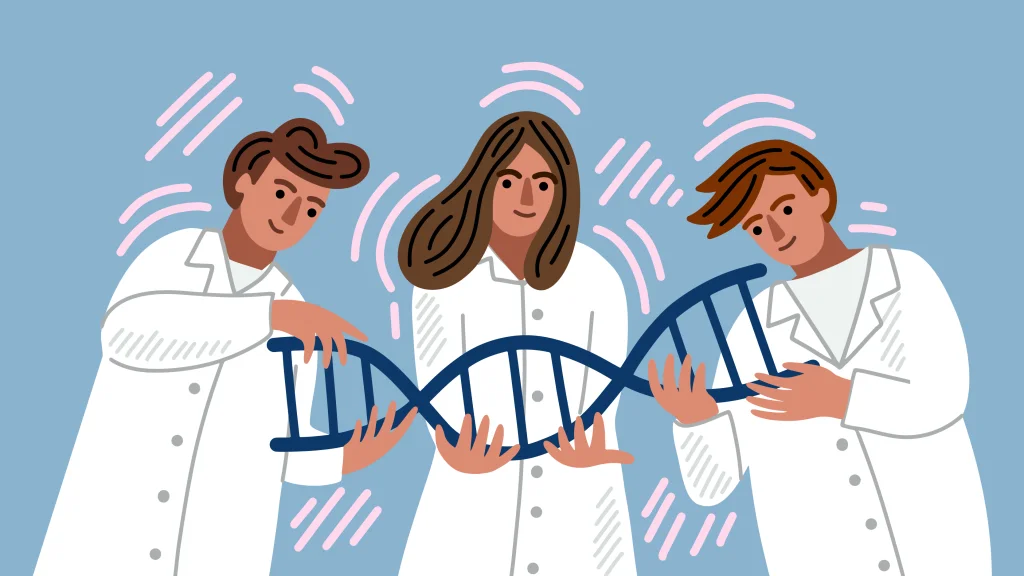
Genetics is the principal conductor in the symphony of human health, directing a multitude of biological processes that influence our health. This is seldom truer than when it comes to cholesterol, where a complex web of hereditary factors interact to determine a person’s fate in terms of heart health. This investigation aims to uncover the intricate interactions between genes that predispose certain individuals to the difficulties associated with regulating cholesterol by penetrating the layers of complexity within the genetic landscape of high cholesterol.
Read More – Daily Care Routine During Pregnancy That A To Be Mother Should Follow
Variations in important genes involved in the metabolism of cholesterol are at the center of this genetic ballet. One major factor that controls the removal of LDL cholesterol from the bloodstream is the LDL receptor gene. Its mutation throws off this vital mechanism, making people susceptible to LDL levels that are consistently elevated—a defining feature of familial hypercholesterolemia.
Proprotein convertase subtilisin/kexin type 9 (PCSK9) and apolipoprotein B (apo B) each contribute special motions to the choreography. The way the body processes and regulates cholesterol is influenced by two factors: PCSK9, a regulator of LDL receptor degradation, and ApoB, a structural component of LDL particles. Variations in these genes can tip the scales, adding to the genetic susceptibility to high cholesterol.
By deciphering the genetic code underlying hypercholesterolemia, we provide light on the mechanisms by which our inherited genetic makeup affects cardiovascular health. This genetic discovery emphasizes the value of early detection via genetic testing and serves as a guide for customized therapy. As we make our way through this genetic landscape, it becomes evident that understanding the complexities of the genetic dance is more than just a theoretical endeavor. It is an essential first step toward customized cholesterol management techniques that strike a healthy balance between genetics and preventive health decisions.
The genetic tapestry of cholesterol
Genetics is the master weaver in the complex web of cholesterol control, creating each person’s distinct cholesterol profile. The production, transport, and breakdown of cholesterol throughout the body are all delicately regulated by a symphony of activities that are orchestrated by the genes. The delicate equilibrium created by these genetic variants can unfold into a complex story that results in illnesses like familial hypercholesterolemia. This is where the genetic ballet takes place.
The production of cholesterol, which is regulated by a number of genes, is the first note of the symphony. Genetic factors control HMG-CoA reductase, an essential enzyme in the manufacture of cholesterol, which affects the delicate balance of cholesterol in the body. Changes in these genes have the potential to tip the balances, resulting in excessive production and high cholesterol.
The movement of this essential material turns into another choreographed act. Genes control the synthesis of lipoproteins, which are the vehicles that carry cholesterol through the bloodstream. The dynamics of this transportation are influenced by the dance of apolipoproteins, especially apoB, and genetic variations can change the dynamics, adding to the high cholesterol associated with familial hypercholesterolemia. The breakdown of cholesterol, an essential step in preserving equilibrium, is also influenced by genetic variations. The LDL receptor gene, acting as a gatekeeper, controls the removal of LDL cholesterol from the bloodstream. Mutations in this gene can cause a malfunctioning gate, keeping LDL cholesterol in the bloodstream and increasing the risk of familial hypercholesterolemia.
The genetic tapestry of those who have this illness reveals a story of familial propensity in which the inherited script specifies a difficult path toward cholesterol management.
Comprehending this genetic mosaic provides not only an insight into the intricacy of cholesterol dynamics but also acts as a benchmark for customized therapies. By revealing the distinctive patterns woven into each person’s genetic fabric, genetic testing provides a tool for early identification and focused treatment. The involvement of genes in familial hypercholesterolemia, in the broad scheme of the genetic symphony, emphasizes the necessity for accuracy in figuring out the complexities of cholesterol regulation and provides hope for customized approaches in the quest of cardiovascular health.
Statistics
According to the Centers for Disease Control and Prevention (CDC), the prevalence of familial hypercholesterolemia (FH) casts a spotlight on its impactful reach, affecting approximately 1 in 250 individuals worldwide. This statistic underscores the widespread significance of this genetic condition in the global population. Familial hypercholesterolemia is not merely a numerical abstraction; it translates into a substantial cohort facing heightened risks of premature cardiovascular disease.
The stark reality is that individuals with FH have a 22 times higher risk of developing coronary heart disease compared to those without this genetic predisposition, as reported in studies published in the Journal of the American College of Cardiology. These statistics echo the urgent need for awareness, early detection, and targeted interventions, emphasizing the critical role of genetics in shaping the landscape of cardiovascular health on a global scale.
Contributing Genetic Factors
The LDL receptor gene plays a crucial role in coordinating the intricate process of cholesterol clearance within the complex realm of lipid genetics. This gene’s precise function of eliminating LDL cholesterol from the bloodstream is interfered with by mutations. Consider the LDL receptor as a gatekeeper. When the gene isn’t working properly, the gate stays open, enabling LDL cholesterol to continue and raise levels.
Apolipoprotein B (apoB) enriches this genetic story with additional information. Because apoB is a structural element of LDL particles, it affects how the body metabolizes and regulates cholesterol. Further impacting cholesterol metabolism, anomalies in LDL particles can result from genetic polymorphisms in apoB.
Proprotein convertase subtilisin/kexin type 9 (PCSK9) is another protein that is under the genetic microscope. This gene affects how well the body removes LDL cholesterol by controlling how LDL receptors degrade. Genetic differences in PCSK9 have the potential to interfere with this regulatory system, which in turn raises the risk of cardiovascular disease by raising LDL cholesterol levels.
These genetic nuances highlight the complex process of cholesterol regulation, in which the destiny of cholesterol molecules in the circulation is determined by an ensemble of genes. Deciphering the genetic subtleties that affect cholesterol metabolism through the influence of the LDL receptor gene, apoB, and PCSK9 provides insight into possible targets for therapies meant to preserve a harmonious balance in cardiovascular health.
Statistics
According to a study that was published in the Journal of the American College of Cardiology, people who have familial hypercholesterolemia are 22 times more likely to have coronary heart disease than people who do not. If we want to change this elevated risk trajectory, early detection and intervention are essential.
Pharmacogenomics
For people with genetic predispositions to cholesterol management, this field provides customized strategies. Particularly useful are drugs that prevent the manufacture of cholesterol, such as statins. Personalized treatment strategies are crucial since hereditary characteristics might affect how well a patient responds to treatment.
Lifestyle Modifications
Genetics may set the stage, but lifestyle decisions can change the course of events. Living changes are much more important for those who are genetically predisposed to high cholesterol. A heart-healthy diet, consistent exercise, and quitting smoking can all have a good effect on cholesterol levels and are crucial cornerstones of overall management.
In summary
Genetics contributes a distinct note to the health symphony by determining the course of cholesterol levels. Recognizing the hereditary component of hypercholesterolemia provides opportunities for focused therapies that combine the field of genomics with individualized medicine. In spite of hereditary propensity, the possibility of early detection and precise therapies appears as we work to decode the genetic code of high cholesterol, providing hope for a healthier cardiovascular future.
Read More – The Impact Of Diet On Cholesterol Levels: Myths And Facts



